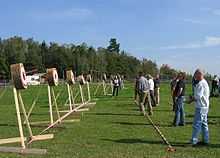Knife throwing

Knife throwing is an art, sport, combat skill, or variously an entertainment technique, involving an artist skilled in the art of throwing knives, the weapons thrown, and a target.
Basic principles
Knife throwing, whether in a martial or sport application, involves the same basic principles of mechanics. The objective in each case is for the point to stick into the target with a sufficient amount of force. For this to be successful, accuracy, distance, number of rotations and placement of the body all must be taken into account unless a no-spin technique is employed by the thrower (there are spin and no-spin throwing techniques). If the thrower uses a spin technique, the knife will rotate during flight.[1] This means that the thrower, assuming he is throwing the same way every time, must either choose a specific distance for each type of throw or, more practically, make slight adjustments to placement of the knife in the hand as well as angle of release and rotation of the wrist. Variations in throw technique can allow great accuracy and range. Throwers may also need to adjust for throwing off-center, around corners, and while running. Another adjustment that can be made is the way the knife is held. If it is held at the blade when it is thrown, this makes it spin half, whereas if it is held by the handle, this makes a full spin. So if you estimate you need one and a half spins for the point to hit the target, you would hold the knife from the blade when it is thrown. If you feel you need two full spins for it to hit the target point-first, then it would be held by the handle.
Sport

In the USA and in Europe, there are communities of people pursuing knife throwing as a sport, similar to archery. Groups such as IKTHOF (International Knife Throwers Hall of Fame, USA), AKTA (American Knife Throwers Alliance, USA) and Eurothrowers (European Throwing Club "Flying Blades", EU) sponsor events, demonstrations and competitions. Those are an opportunity for the throwers to exchange knowledge, compare their performances, and enjoy the amiable atmosphere common to those events.
The competition itself consists, in the most common form, of a series of straight throws aimed at a set of standard wooden targets or in some cases foam. Similar to an archery target, competition knife throwing targets have a bullseye surrounded by one or more rings. A sticking knife scores points. The thrower must be standing at least a set distance away from the target, with higher distances for more challenging events. IKTHOF keeps a ranking of its members based on their performance during these sponsored competitions. The scores achieved at Eurothrowers events can be examined at the meetings' reports.
Martial arts
Although it was popularized in America in the late 19th century by traveling acts such as the Barnum & Bailey Circus, the history of knife throwing dates much further back. The art of knife throwing was first used in martial arts or hunting applications. It has been incorporated into the martial disciplines of the Japanese as well as some African and Native American tribes. In such cases, throwing a weapon when fighting is generally thought of as a risk. If unsuccessful it can leave the thrower without a weapon and arm your attacker. However, many warriors traditionally carried two or more weapons at the same time.
In popular culture
Knife throwing as entertainment is part of a group of performance arts sometimes known as the impalement arts.[2] In the popular young adult novel The Hunger Games, Clove uses throwing knives as her weapon of choice.[3]
Representations
The opera Queen of Knives, which premiered in Portland, Oregon on May 7, 2010 tells the story of a brother and sister knife throwing act in the midst of the student protests in Birmingham in the early 1960s.[4]
See also
Notes and references
- ↑ "Physics of knife throwing". Retrieved 8 July 2013.
- ↑ "Knife Throwing Family - Universal Newsreel". Texas Archive of the Moving Image. c. 1950s. Retrieved 4 August 2011.
- ↑ "Clover′s knives int the movie Hunger Games". Retrieved 13 January 2013.
- ↑ McQuillen, James, Opera review: "Portland's Vagabond Opera's 'Queen of Knives' is one sharp show", The Oregonian, May 11, 2010
Sources
- Collins, Blackie. Knife Throwing-Sport – Survival – Defense. Knife World Publications, 1978. (ISBN-0-940362-03-1)
- Echanis, Michael D. Knife Fighting: Knife Throwing for Combat. Ohara Publications, 1978. (ISBN-0-8975-0058-X)
- Hibben, Gil. The Complete Gil Hibben Knife Throwing Guide. United Cutlery Corp., 1994. (ASIN-B0006FAV9E)
- Madden, James W. The Art of Throwing Weapons. Patrick Publications, 1991. (ISBN 0-9628825-3-4)
- McEvoy, Harry K. Knife Throwing: A Practical Guide. Charles E. Tuttle Company, Inc., 1973. (ISBN-0-8048-1099-0)
- McEvoy, Harry K. Knife and Tomahawk Throwing. Knife World Publications, 1985. (ISBN 0-940362-10-4)
- McEvoy, Harry K. Knife & Tomahawk Throwing-Art of the Experts. Charles E. Tuttle Company, Inc., 1988. (ISBN-0-8048-1542-9)
- Moeller, Harald. Knifethrowing: The Viper Story. Lynclif Publishing, 1988. (ISBN 0-921444-00-1)
External links
- Knife throwing technique
- International Knife Throwers Hall of Fame (USA)
- American Knife Throwers Alliance (USA)
- European Throwing Club "Flying Blades" (EU)
- Types of Throwing Knives